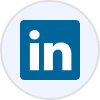Product Discovery: Definition, Process, and Real-World Examples
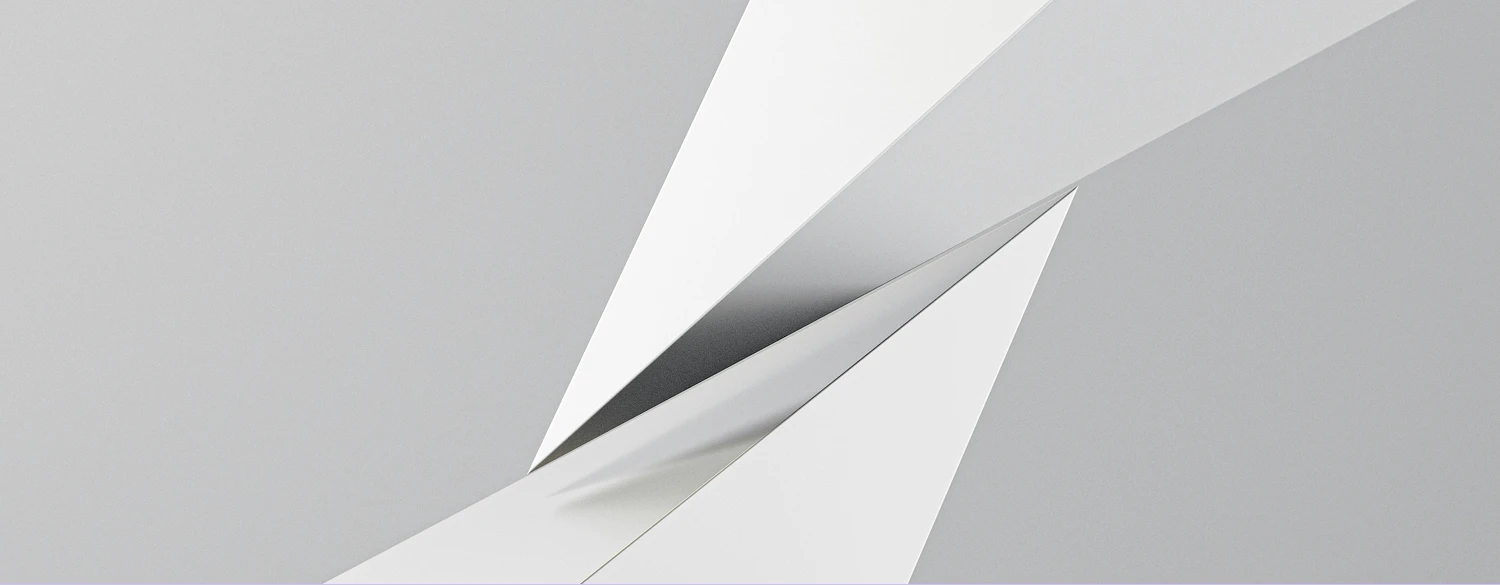
You’ve read the books, interviewed users, and held team sessions, but product discovery still feels directionless.
Most project managers grapple with this foundational question at some point in the project lifecycle.
- PMs overwhelmed by ambiguity in discovery frameworks
 Overwhelmed PMs seek simple product discovery techniques (Source: Reddit)
Overwhelmed PMs seek simple product discovery techniques (Source: Reddit)- Teams stuck in outdated processes with limited stakeholder support
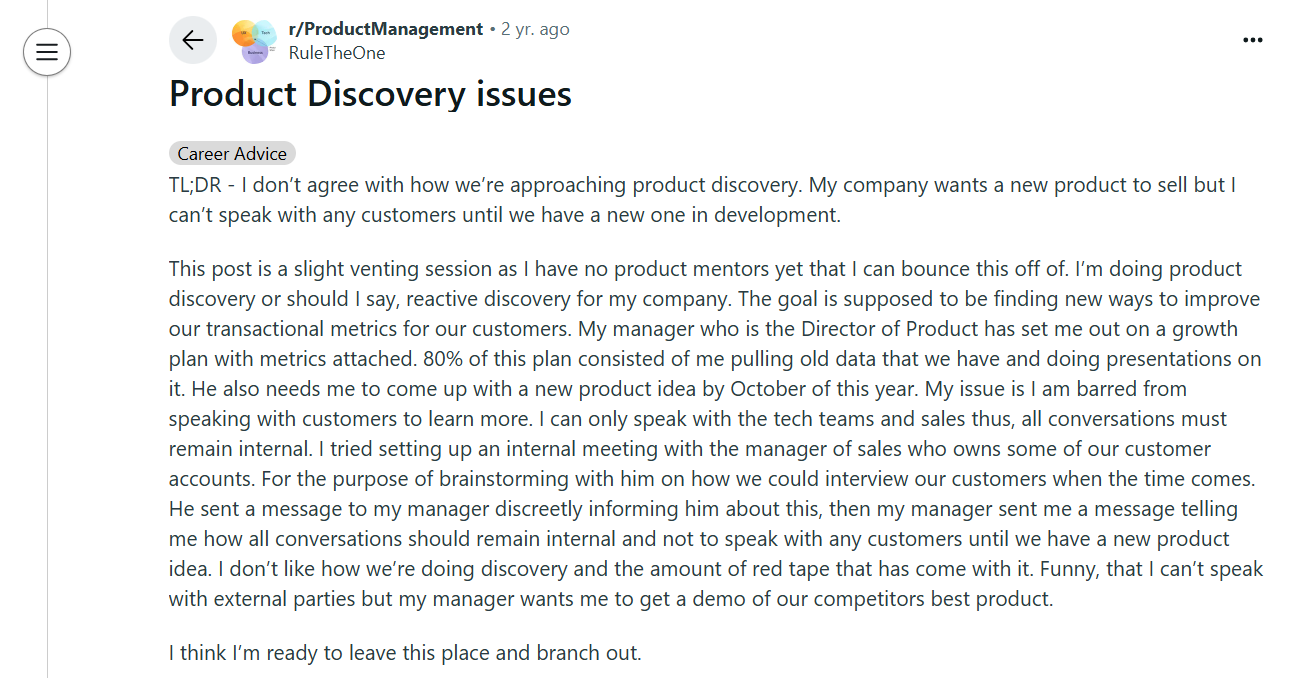 Product managers disagree with company on product discovery process (Source: Reddit)
Product managers disagree with company on product discovery process (Source: Reddit)In either case, this article will provide the much-needed clarity you seek.
What you'll get:
- A clear definition of product discovery, what it is, what it isn't, and how it's evolved
- A side-by-side comparison of discovery vs delivery, ideation, and customer research
- A practical breakdown of the discovery process and how Meegle supports it
You’ll learn how to cut through ambiguity, validate ideas faster, and see how Meegle gives PMs a structured, repeatable path to evidence-backed product decisions.
What is product discovery? Everything you must know
Product discovery is the upfront process of identifying unmet user needs, such as workflow inefficiencies, feature gaps, or decision bottlenecks, and testing potential solutions through interviews, prototypes, and data analysis. It guides product decisions like feature prioritization, user flow design, and problem-solution fit. The goal is to reduce wasted development effort and drive outcomes such as user adoption, retention, and revenue impact.
What is a product discovery framework?
A product discovery framework is a structured, repeatable methodology that guides product teams through identifying user problems, validating solution ideas, and prioritizing features before development begins. It defines the steps, tools, roles, and decision criteria needed to run discovery consistently and reduce product risk.
Note:
- Product discovery is the practice.
- A product discovery framework is the structure that helps teams practice it effectively and consistently.
Used early in the product lifecycle, discovery frameworks serve three key functions:
- Test critical assumptions - for example, whether users actually want a proposed feature or workflow change
- Minimize product risk - such as misaligned features, low adoption, or wasted engineering resources
- Focus team efforts - by concentrating on high-impact areas like onboarding, integration points, or workflows tied to activation and retention
By grounding product decisions in customer pain points, behavioral patterns, and market context, the framework enables teams to shift from guesswork to clarity. It ensures that what gets built is both valuable to users and aligned with business objectives.
Who is responsible for the product discovery process?
The product manager leads the product discovery process, setting the direction by defining the problem space, outlining discovery goals, and ensuring the team investigates real user needs, not just feature requests. They own the decision-making but work closely with a cross-functional team that shapes and validates every step.
Key collaborators include:
- UX designers, who plan and conduct user interviews, usability tests, and prototype experiments. Their research identifies behavioral patterns, unmet needs, and usability barriers that might not surface through quantitative data alone.
- Engineers, who evaluate the technical feasibility of early ideas, raise implementation constraints, and often propose alternative solutions based on system knowledge or architecture patterns. Their early involvement reduces delivery risk later.
- Stakeholders from sales, marketing, and support, who share recurring customer objections, feature requests, and competitive insights. These inputs help the team prioritize discovery efforts around high-impact user and business problems.
- Data analysts, when available, explore usage patterns, conversion drop-offs, and customer cohorts. Their analysis highlights areas worth investigating further or helps confirm signals emerging from qualitative research.
By collaborating and bringing their diverse expertise early in the process, the discovery team avoids tunnel vision and builds a shared understanding of both the opportunity and the constraints.
How product discovery has evolved
Product discovery was once treated as a one-time task, something founders or product managers completed quickly to justify a feature or secure stakeholder buy-in.
The result: feature-stuffed roadmaps, long development cycles, and products misaligned with real user needs.
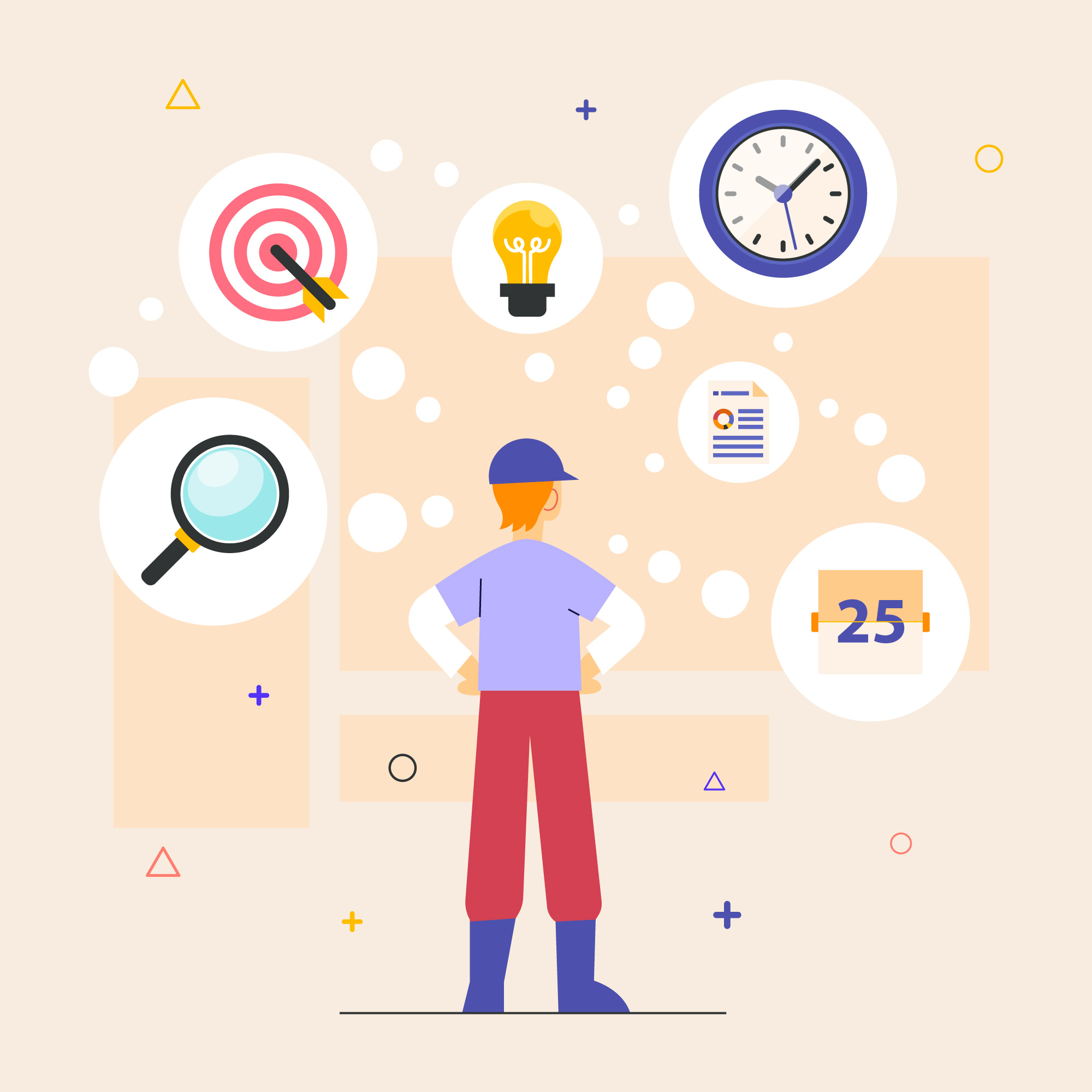 Product discovery (Source: Freepik)
Product discovery (Source: Freepik)Today, product discovery has shifted from assumption-based planning to continuous, evidence-led exploration. Below are three specific areas where this change is most visible:
1. Feature planning
- Then: Teams prioritized features based on internal opinions or leadership preferences, often without user input.
- Now: Teams begin with problem framing, followed by interviews, usability tests, and feedback loops to validate which pain points are worth solving, and how.
2. Competitor research
- Then: Discovery involved tracking competitor roadmaps and copying popular features.
- Now: It focuses on identifying gaps in the user experience, analyzing behavior patterns, and creating differentiated solutions based on firsthand user insight.
Suggested read: 👉7 Product Roadmap Examples to Guide Your Strategy
3. Discovery timeline
- Then: Discovery happened only once, usually before kickoff.
- Now: It is integrated into every stage of the product lifecycle. Teams revisit discovery during backlog grooming, after launches, and when user behavior shifts, ensuring the roadmap stays relevant.
Modern product discovery is no longer reactive or isolated. It’s a structured, cross-functional practice that combines research, validation, and iteration to make sure teams are solving the right problems, at the right time, with solutions users will adopt.
What the are the key goals and benefits of product discovery?
Product discovery gives teams a clear, structured path to define what to build and why. Each goal ensures that development efforts focus on high-impact, user-aligned opportunities.
| Goal | Purpose |
|---|---|
| Surface actionable user problems | Pinpoints friction in user workflows, unmet needs, or broken experiences based on direct evidence, from interviews, usage data, or support logs. |
| Test and refine solution directions | Gauges user response to early concepts through prototypes, mock flows, or feedback loops, allowing teams to shape features before design or development. |
| Map product choices to business priorities | Links roadmap decisions to specific outcomes like improved onboarding conversion, faster task completion, or increased customer lifetime value. |
| Strengthen launch readiness | Ensures proposed solutions meet usability benchmarks, solve the intended problem, and support measurable success criteria before moving forward. |
A strong discovery process reduces ambiguity, sharpens focus, and increases the likelihood of building solutions that perform, both for users and the business.
Product discovery vs. product delivery: What's the difference?
Before you build anything, you need to know the "what" and "why." That's the job of product discovery. Delivery, on the other hand, is how you bring the solution to life.
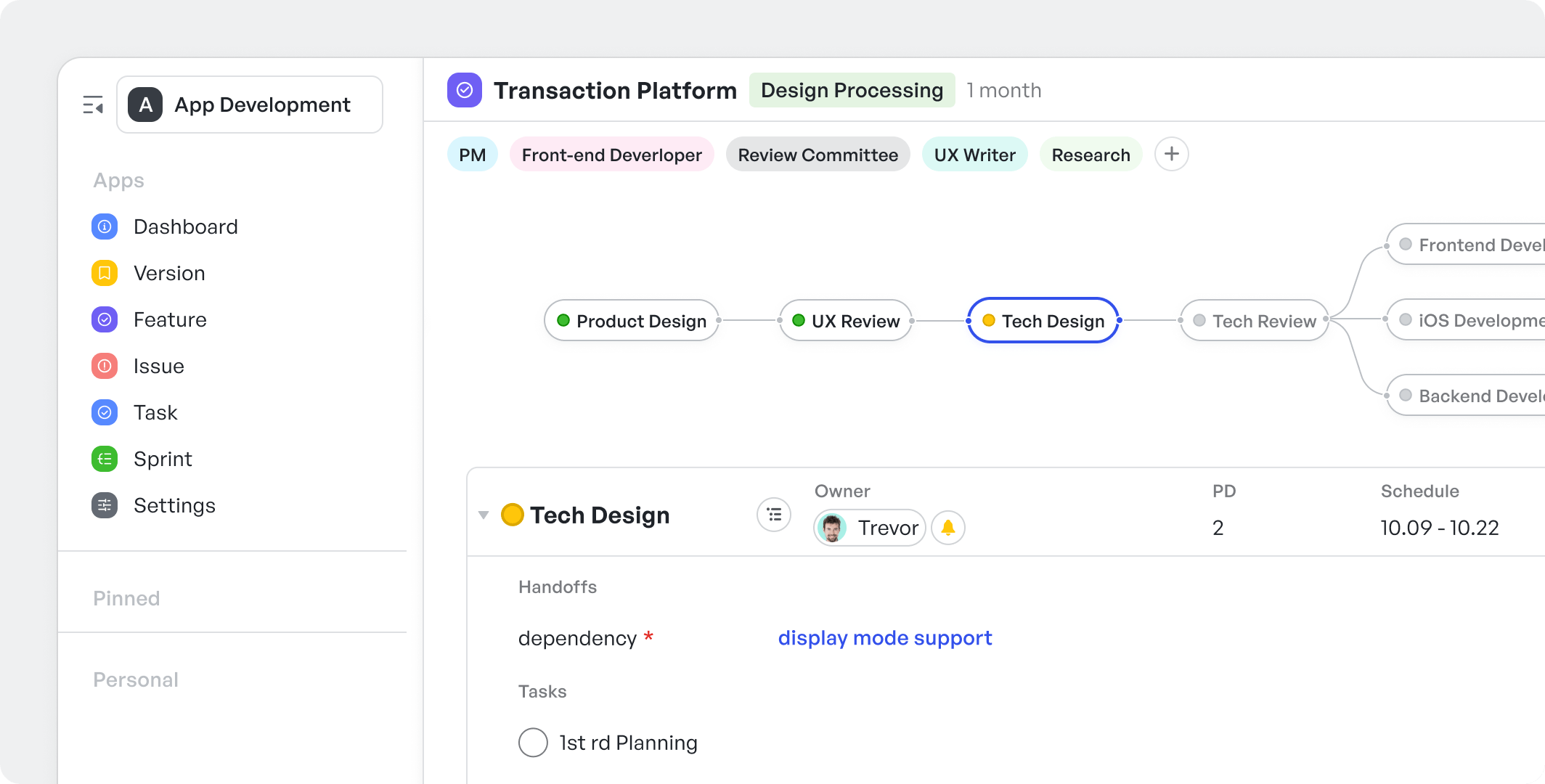 Meegle's App development template - pre-defined and customizable
Meegle's App development template - pre-defined and customizableProduct discovery vs. delivery
Product discovery and delivery serve distinct purposes in the product lifecycle. Discovery focuses on identifying and validating the problem, while delivery involves building, testing, and launching the solution that addresses it. The two stages require different mindsets, tools, and collaboration patterns, but must stay tightly aligned to produce meaningful outcomes.
Here are concrete examples that illustrate the distinction:
Example 1: Fintech app – expense automation During discovery, the team analyzed user behavior and found that most users dropped off when asked to manually categorize expenses.
The problem: tracking spending felt tedious and error-prone. In delivery, engineers implemented automated expense categorization using OCR and bank integrations to streamline the experience.
Example 2: Health app – trust in AI Through in-depth user interviews, the team uncovered a pattern: users were skeptical of AI-generated health advice and wanted to understand the rationale behind suggestions. Delivery involved adding in-app explanations for each recommendation and offering access to human coaches during critical decision points.
Example 3: HR SaaS – probation period management Continuous feedback from HR managers revealed that tracking employee probation timelines was inconsistent and often led to missed reviews. The discovery phase defined the exact triggers and reminders users needed. Delivery translated that into a feature set: automated alerts, a centralized dashboard, and custom notification settings.
In short, discovery defines the “why” and “what”, the user problem, the context, and the opportunity, while delivery addresses the “how” through execution, design, and deployment.
In short, discovery ensures you build the right thing; delivery ensures it gets into users' hands fast and well-executed.
Check out Meegle's App development template
Customer research vs. Product discovery
Customer research is a critical input to product discovery, but not the entire process. It focuses on collecting data: interviews, surveys, behavioral logs, and support interactions. Product discovery takes those inputs forward, using them to define problems, explore solution directions, and determine what’s worth building.
Here’s how the two differ in practice:
Example 1: HR SaaS – burnout tracking The product team conducts interviews with HR leaders and uncovers a recurring pain point: difficulty spotting early signs of employee burnout. That insight stems from customer research. Discovery begins when the team reframes the feedback into a clear problem statement, explores intervention options, and tests lightweight solutions, like weekly pulse surveys or time-off trend alerts, to evaluate effectiveness.
Example 2: Fintech – loan repayment clarity Support data shows a spike in user confusion around loan repayment terms. That’s raw insight gathered through customer research. The discovery phase starts when the team hypothesizes that a repayment simulator could help and prototypes it. After usability testing and feedback, they validate which version best improves user comprehension and confidence.
Example 3: EdTech – personalized learning paths A survey reveals that learners want tailored content rather than static course modules. While this input reflects a preference, it doesn’t confirm what will work. Discovery involves testing whether AI-generated paths actually improve engagement and completion rates, using A/B tests and behavior tracking before committing to development.
In short, customer research tells you what users say. Product discovery uncovers what actually solves their problems. The two work together.
Ideation vs. Discovery
Ideation focuses on generating possible solutions, while discovery evaluates which of those ideas address real user problems in a viable, usable way. Ideation opens up options; discovery narrows them down based on user behavior, feasibility, and business value.
Example 1: HR SaaS – manager coaching assistant The team holds a brainstorming session and proposes a tool to help managers offer better coaching feedback. That’s ideation. Discovery begins when they interview managers to understand current pain points, then prototype different formats, such as nudges, templates, or integrated feedback loops, to test usability and relevance in real workflows.
Example 2: Project management – task views During a roadmap planning sprint, the team suggests building ten new task view formats, including timeline, Kanban, and Gantt variants. That represents ideation. In discovery, they explore how users actually manage tasks, then validate which views solve known navigation or tracking issues, often reducing the scope to two or three high-utility formats.
Example 3: Health tech – gamified onboarding A cross-functional team suggests adding game-like progress badges to the patient onboarding journey. Ideation generates the concept. Discovery involves creating prototypes with varying levels of gamification, running tests with new users, and measuring whether engagement improves or if users drop off due to added complexity.
Ideation brings breadth; discovery adds depth. Together, they ensure that solutions are both creative and grounded in user evidence.
In summary, ideation fills your backlog; discovery filters it.
Bottom line
Product discovery, customer research, and ideation all feed into delivery. But they serve different purposes.
- Customer research uncovers real problems.
- Ideation explores possible solutions.
- Discovery tests them against user and business needs
- Delivery builds the ones that pass the test
Together, they form a cycle: you research, ideate, validate, and then build. Leave one out, and you risk shipping something that doesn’t solve a real need.
7 Product discovery phases/processes
The product discovery process is a structured journey. Below is a quick summary of the 7 key phases and their purpose:
| Phase | What happens | Key activity |
|---|---|---|
| Phase 1: Identify assumptions | Identify assumptions about your users, market, and product | Conduct hypothesis testing and gather data |
| Phase 2: Conduct user research | Engage with real users to gather qualitative and quantitative insights | Conduct surveys, interviews, and usability tests |
| Phase 3: Synthesize insights | Analyze and organize the research findings to extract meaningful insights | Identify patterns and opportunities |
| Phase 4: Generate solution ideas | Brainstorm potential solutions to meet the user's needs and business goals | Ideation sessions and solution validation |
| Phase 5: Test early ideas | Validate ideas with early prototypes or MVPs to assess user feedback and viability | User testing with wireframes or prototypes |
| Phase 6: Prioritize opportunities | Rank the opportunities based on impact, feasibility, and alignment with business goals | Use frameworks to prioritize features |
| Phase 7: Establish a shared understanding | Ensure all stakeholders are aligned on the goals, features, and roadmap for the next steps | Align teams with a shared roadmap |
Product discovery phase 1: Identify assumptions
In the first phase of product discovery, the team articulates what’s presumed true:
What do we think we know?
These include assumptions about:
- What users want
- What problems matter most
- How the product supports business goals
- Whether it’s technically feasible
For example:
- A B2B HR software development team may assume recruiters want AI-powered candidate scoring. On the other hand, user interviews suggest that the real pain is scheduling interviews.
- A fintech startup may assume users want budgeting features, only to learn they're more concerned with instant balance alerts.
With Meegle, product teams can make this phase less strenuous. Using Meegle's visual workflows, teams can visually group assumptions, tag them by risk, and assign validation tasks, so the riskiest ideas are tested first.
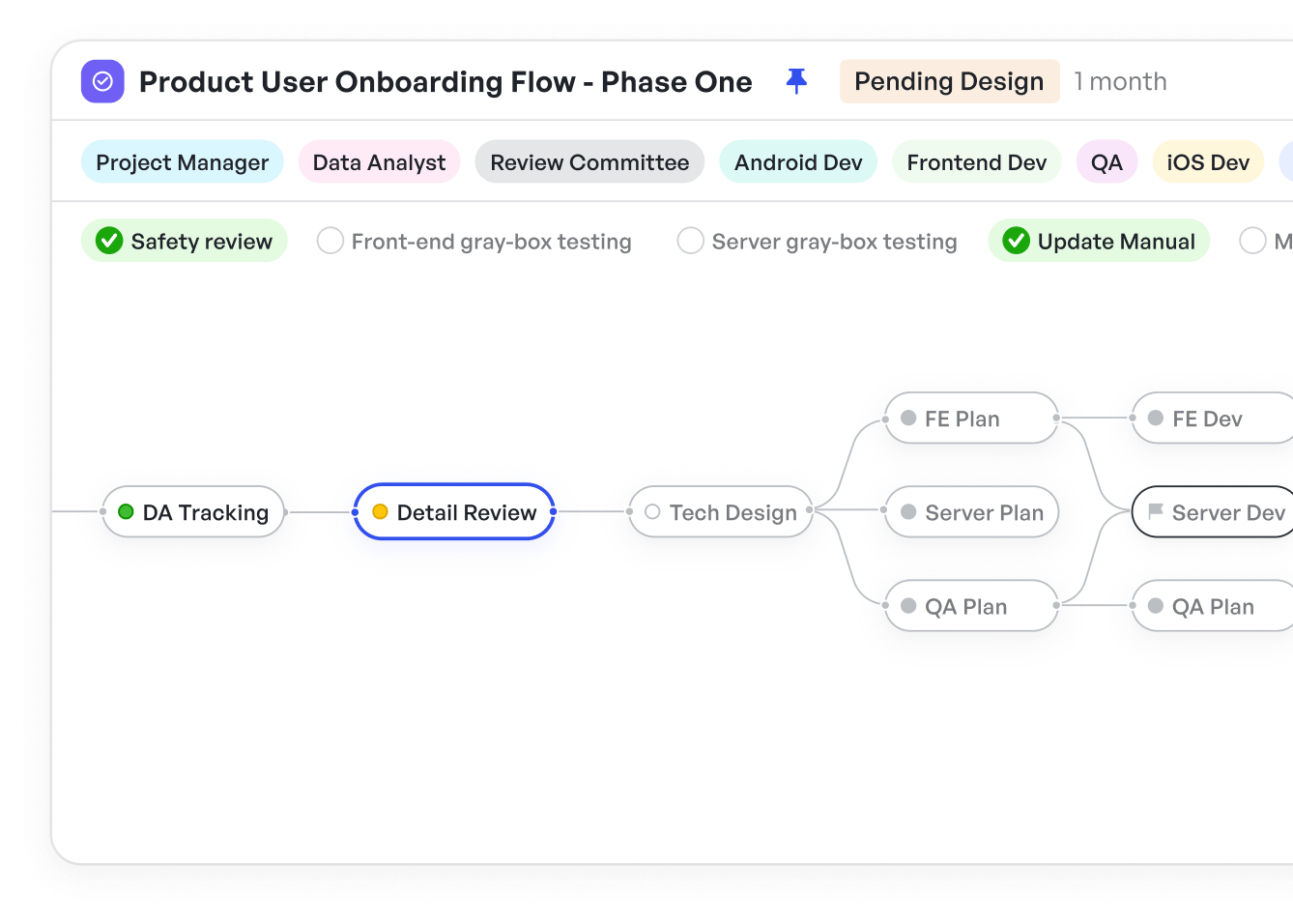 Sort assumptions into nodes for validation
Sort assumptions into nodes for validationThen, you can prioritize what needs validation.
What's in vs. what's out:
| What’s in | What’s out |
|---|---|
| Listing out assumptions | Relying on past projects as "proof" |
| Tying each assumption to a user segment or goal | Jumping into delivery without questioning key ideas |
| Developing lightweight tests for high-risk assumptions |
Product discovery phase 2: Conduct user research
This phase is where you turn assumptions into valuable insights. You engage with real users through interviews, surveys, and behavior tracking to uncover what they actually need, not what they say.
For example:
- A payroll SaaS team assumed users struggled most with year-end tax reports. After conducting 10 interviews, they found onboarding confusion was costing more users.
- An edtech app focused on kid-friendly features till surveys showed it was parents, not students, making the final purchase decision.
Ultimately, you’re looking for pain points, mental models, and context to guide your next decisions. And you can log all the research data (notes, recordings, and feedback) in the Meegle nodes from phase 1. This way, you centralize your findings into one dashboard.
You can avoid onboarding issues with this Meegle template. The onboarding template assists HR in organizing and managing the onboarding process more efficiently.
What's in vs. what's out:
| What’s in | What’s out |
|---|---|
| 1:1 interviews, surveys, screen recordings | Internal guesses or assumptions |
| Tagging insights by themes or pain points | Drawing conclusions from single anecdotes |
| Watching how users interact (not just hear) | Skipping research to build faster |
Product discovery phase 3: Synthesize insights
This is where raw research turns into usable direction. Here, you cluster findings, identify recurring patterns, and prioritize pressing user problems.
The goal for this phase is to help the team focus on the high-priority features. In real life, it looks like this:
- 80% of users of a benefits platform cited poor mobile UX as the reason for churning. This shifted their dev priorities from feature expansion to mobile optimization.
- A hiring SaaS company mapped insights from interviews and realized HR managers cared less about "speed" and more about accuracy in candidate matching.
In either case, you must involve stakeholders in the product development process for buy-in. Meegle makes this possible with its collaborative features.
Key actors can see how priority shifts in the visual workflows. They receive automated updates about the changes. More importantly, they can give feedback directly within the nodes or @mention the task/node owners.
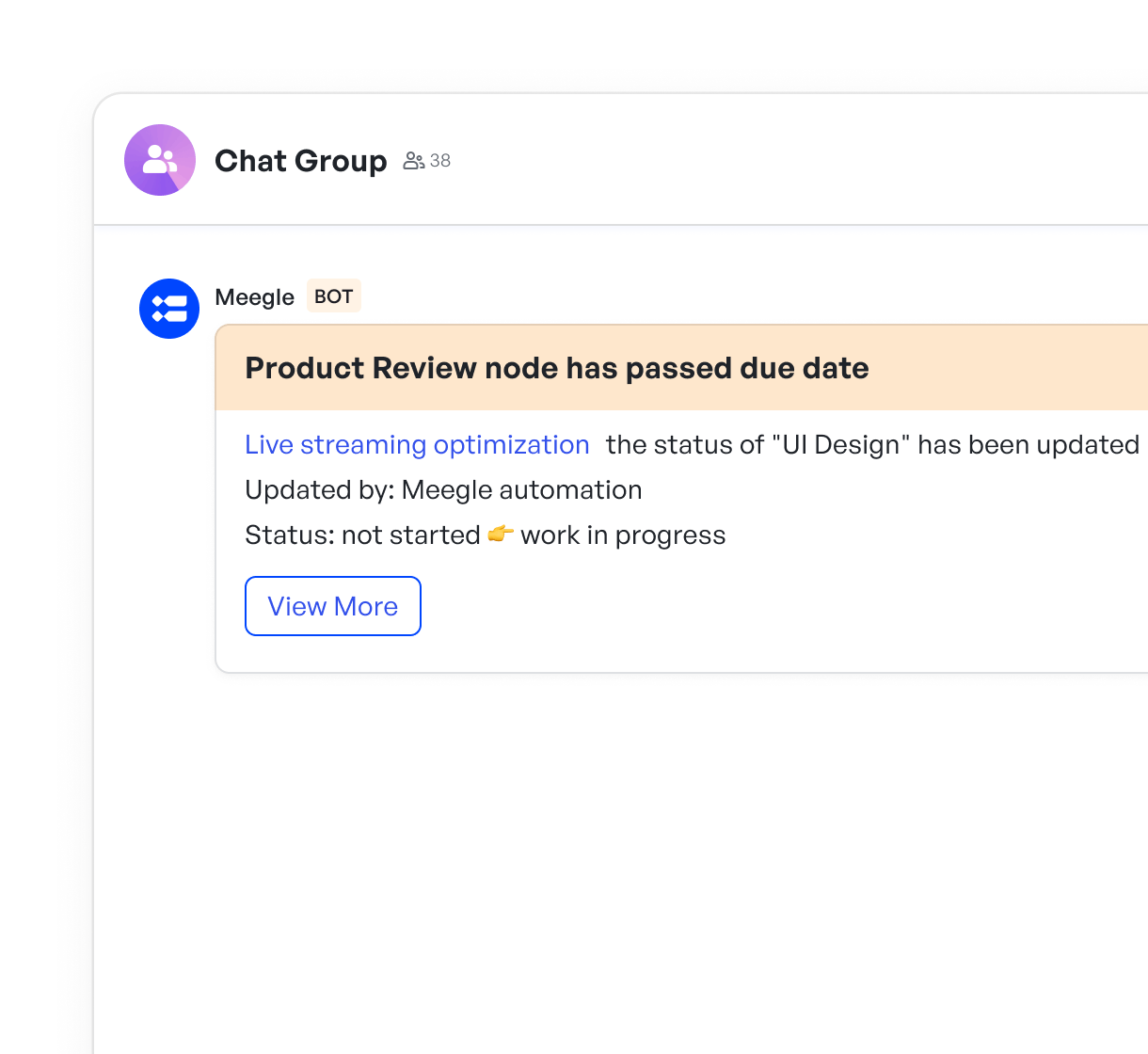 Meegle automation features for keeping stakeholders in the loop
Meegle automation features for keeping stakeholders in the loopWhat's in vs. what's out:
| What’s in | What’s out |
|---|---|
| Grouping data by themes or jobs to be done | Listing feedback without structure |
| Prioritizing issues based on frequency/impact | Treating all insights as equal |
| Building clear problem statements | Jumping straight into solutions |
Product discovery phase 4: Generate solution ideas
With clear problem definitions in place, teams can begin exploring potential solutions. This phase involves cross-functional collaboration (with designers and engineers) to explore ways to address the user needs uncovered during research.
For example:
- A payroll SaaS team rolled out a "single-click pay run" after hearing users complain about multi-step processes.
- An HR tool team sketched several dashboard designs to address confusion around tracking time-off balances.
The aim of this phase? Collaboration. With Meegle, teams can achieve that.
Teams can upload solution ideas to Meegle's visual workflow and connect them to research insights and prototype flows. Then, using the vote button, they can prioritize the idea to execute.
 Voting for features on Meegle
Voting for features on MeegleAlternatively, product teams can use Meegle's Retrospective Voting System Template. It is ideal for complex projects where decision-making and prioritization are critical.
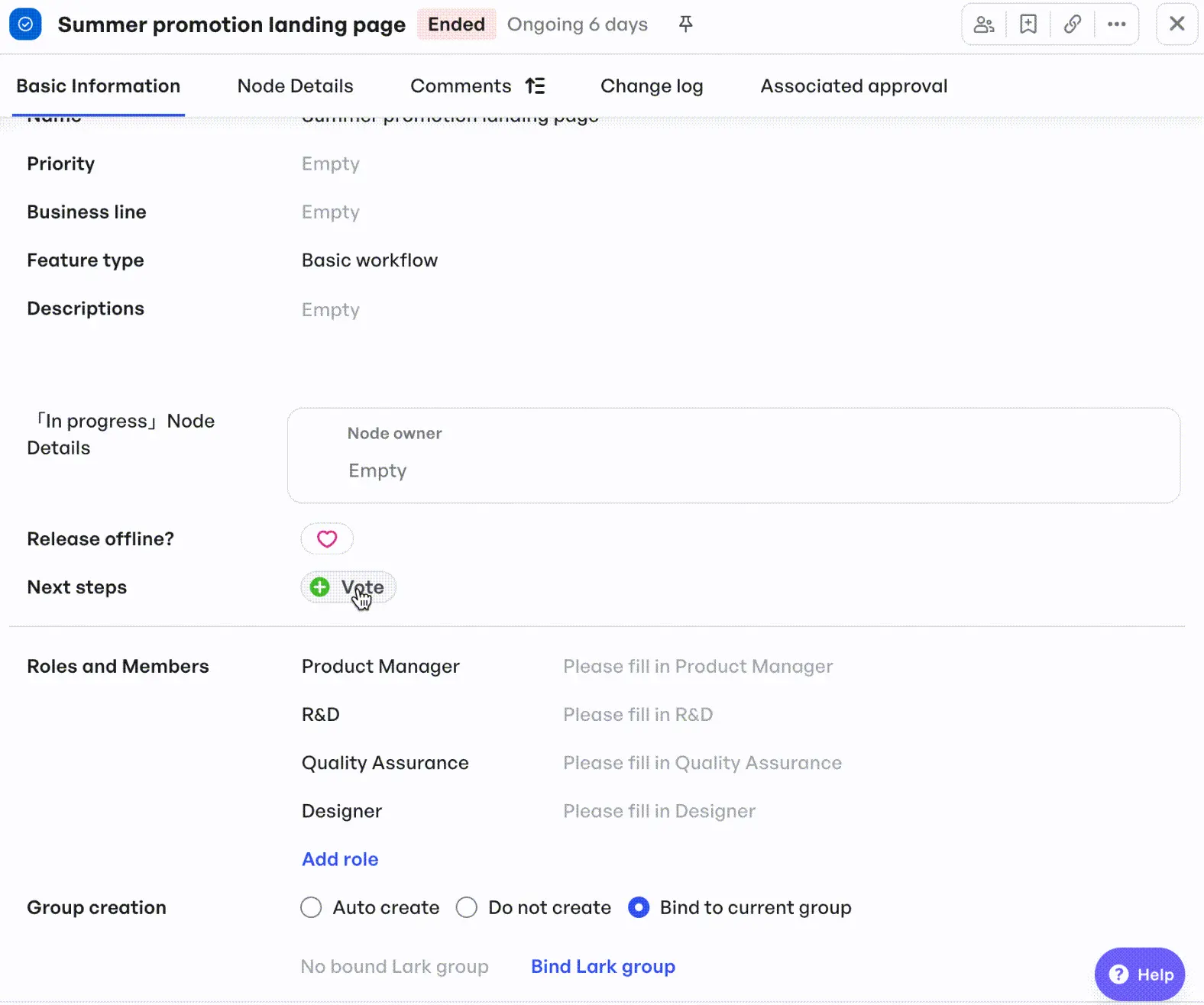 Voting template for cross-functional teams
Voting template for cross-functional teamsWhat's in vs. what's out:
| What’s in | What’s out |
|---|---|
| Cross-functional ideation sessions | Top-down feature requests |
| Sketching multiple solution paths | Jumping into code without options |
| Aligning ideas with insights | Guessing based on trends |
Product discovery phase 5: Test early ideas
Teams test low-fidelity prototypes or early MVPs with real users. The goal is to validate assumptions and gather actionable feedback. The goal is to rapidly learn what works, and refine ideas before committing to code.
In real life, this phase looks like this:
- A recruiting software team tested a clickable prototype for a new "1-click job post" feature with HR leads.
- A wellness app ran a concierge-style test via email before building a scheduling system.
For example, LIZHI, a leading audio platform, used Meegle during early prototyping to streamline testing and cross-team alignment.
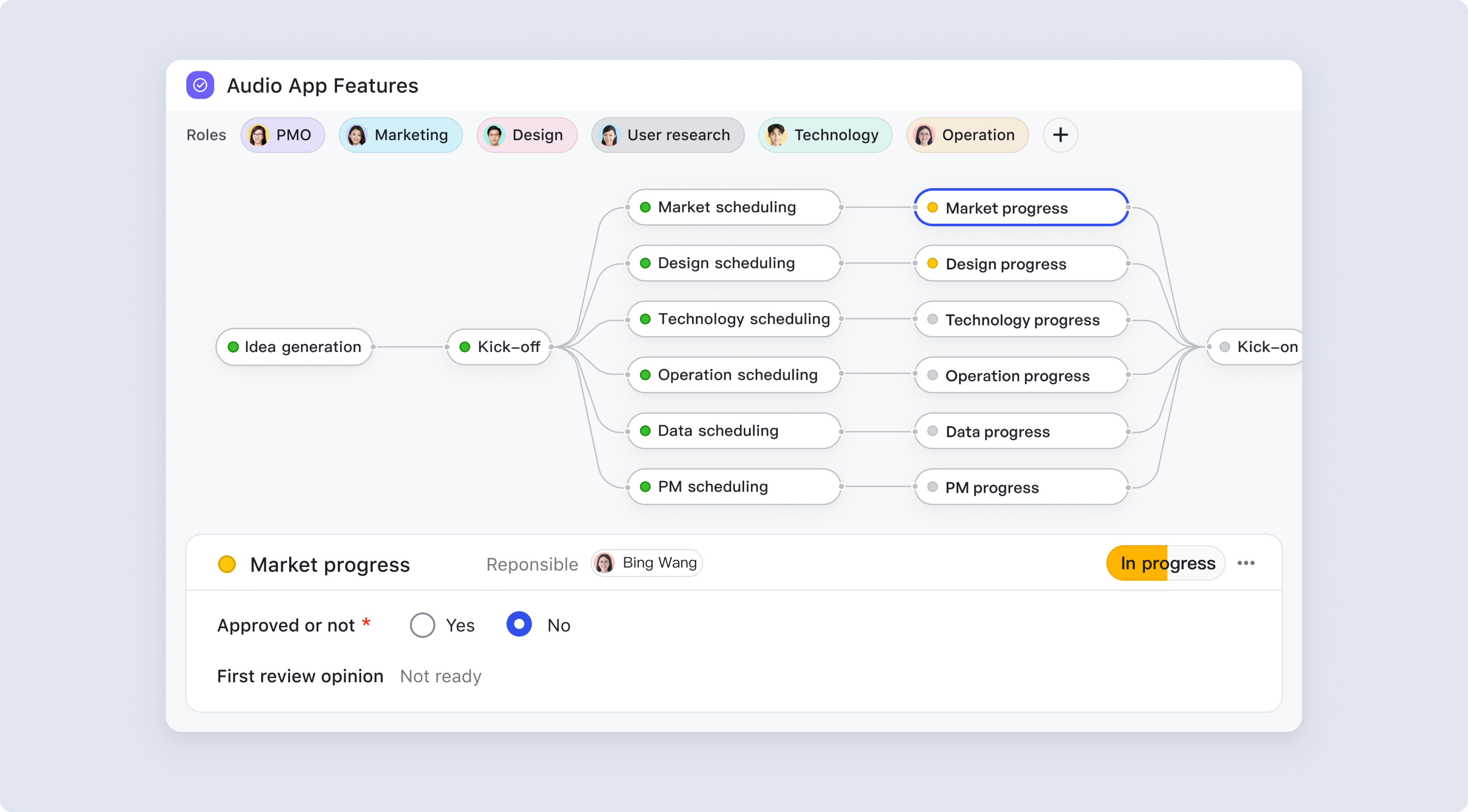 Meegle's product development solution for LIZHI
Meegle's product development solution for LIZHIWith Meegle's node-based workflow, milestone tracking, and cross-functional planning tools, LIZHI cut release time by 50%.
What's in vs. what's out:
| What’s in | What’s out |
|---|---|
| Prototypes and MVP experiments | Full-scale development too early |
| Feedback loops with real users | Internal-only opinions |
| Learning fast and adjusting | Assuming it will work as-is |
Further reading: 👉MVP in Product Management
Product discovery phase 6: Prioritize opportunities
In this phase, teams evaluate all validated insights. Then, they decide what to build first based on user value, business impact, and feasibility. The aim is to focus on opportunities that solve high-priority user problems and drive measurable business outcomes.
For example:
- An HR tech team prioritized automating interview scheduling over building a new analytics dashboard based on user pain points.
- A benefits platform chose to launch mobile enrollment before refining admin features after reviewing usage data.
Either way, this phase requires all insights, user feedback, and decision logic in one place. Meegle brings all insights, feedback, and prioritization data into one workspace, so teams can act decisively.
- Product teams can score opportunities
- They can collaborate with stakeholders and iterate based on feedback
- Visualize and adjust delivery timelines (as needed) using Member Schedule
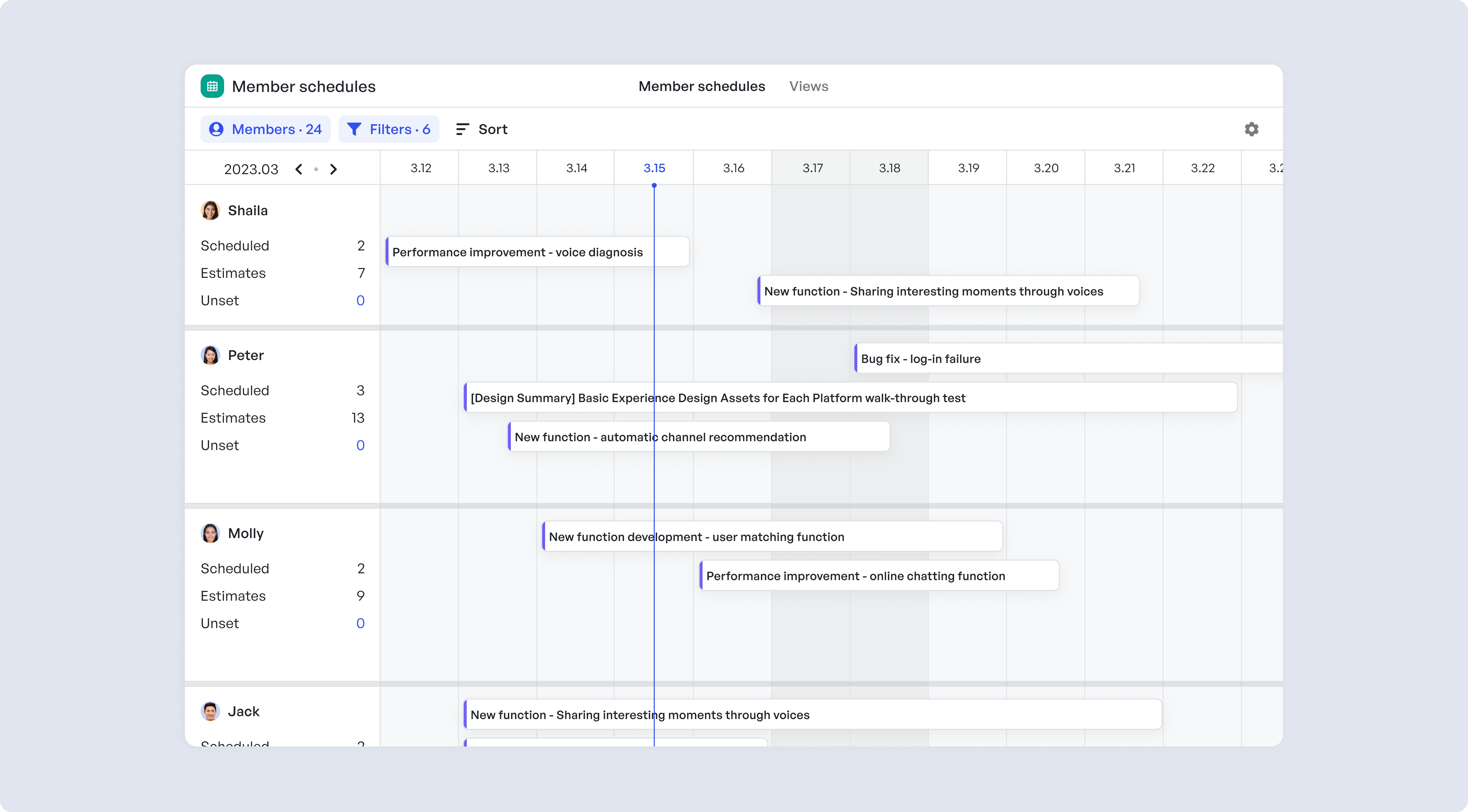 Using Meegle to adjust responsibilities and timelines
Using Meegle to adjust responsibilities and timelinesWhat's in vs. what's out:
| What’s in | What’s out |
|---|---|
| Scoring models like RICE or MoSCoW | Prioritizing based on gut feeling |
| Collaborative input from cross-functional teams | PM-only decision-making |
| Visual, real-time roadmapping with Meegle | Static spreadsheets and outdated docs |
Product discovery phase 7: Establish a shared understanding
In this phase, product teams ensure that everyone (design, engineering, marketing, and leadership) is on the same page about what will be built and why. This alignment reduces rework, prevents silos, and speeds up execution.
For example:
- An HR tech startup might host a cross-functional workshop to align around a new onboarding feature.
- A SaaS platform may create a shared discovery canvas to unify feedback and the next steps.
With Meegle, teams can visually map goals, assign owners, and track feedback all in one place. This keeps communication open and everyone clear on priorities moving forward.
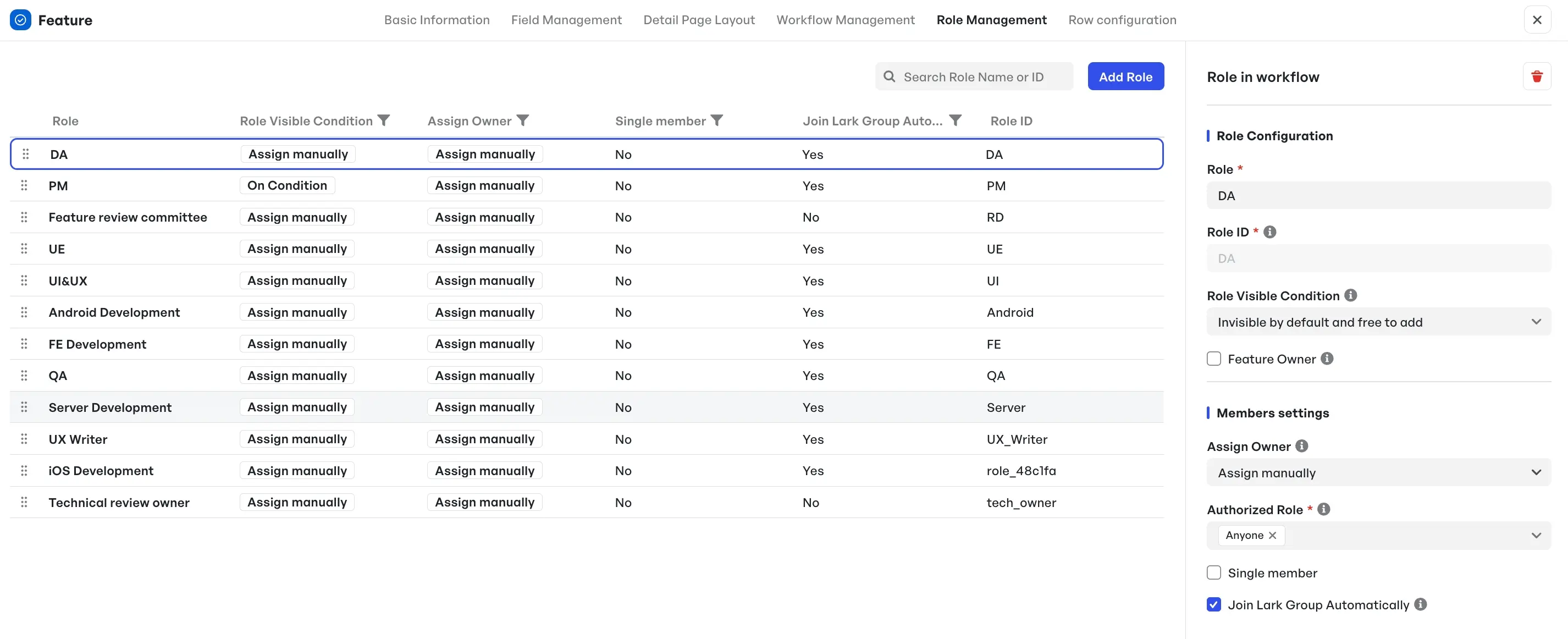 Roles assigned easily using Meegle's workflow feature
Roles assigned easily using Meegle's workflow featureWhat's in vs. what's out:
| What’s in | What’s out |
|---|---|
| Shared visibility into goals and progress | Departmental silos |
| Cross-functional collaboration | One-team-only decision-making |
| Centralized documentation and updates | Scattered notes in emails or chats |
Challenges in product discovery, and how Meegle helps address them
Even experienced product teams encounter friction during discovery. From stakeholder dynamics to gaps in user input, these challenges can delay progress or lead teams down the wrong path. Below are five common obstacles and how Meegle equips teams to overcome them:
1. Decisions driven by internal bias
Ideas often originate from stakeholder opinions or internal discussions without validation from real users. How Meegle helps: Meegle consolidates feedback from interviews, surveys, and usage data into one centralized space. Product managers can reference actual user inputs during planning and avoid prioritizing features based on assumptions.
2. Gaps in access to end users
Without timely input from target users, teams struggle to define the right problems. How Meegle helps: Meegle’s journey mapping and collaborative research tools streamline the entire process, from planning interview scripts to sharing findings, making ongoing research easier to conduct and act on.
3. Misalignment across teams
When product, design, and leadership operate with different priorities or definitions of success, discovery efforts stall. How Meegle helps: Shared dashboards and visual workflows give every stakeholder visibility into discovery progress, priorities, and user evidence, ensuring alignment before decisions are made.
4. Skipping validation under time pressure
Tight deadlines often push teams to commit to delivery without testing key assumptions. How Meegle helps: Structured visual boards in Meegle link every idea or feature to the research and validation that supports it. Teams are prompted to complete discovery phases in order, reducing the chance of premature handoffs.
5. Misreading user feedback
Raw feedback, if not reviewed collaboratively, can lead to incorrect interpretations and weak solutions. How Meegle helps: PMs can upload qualitative inputs into Meegle, tag relevant insights, and invite cross-functional teammates to identify shared patterns, helping the team reach clarity faster.
Take the guesswork out of discovery. See how Meegle helps you move from research to clarity from day one
FAQs
When should product discovery start?
As early as possible, but ideally before any development begins.
Can product discovery be skipped for small features?
No. Even small features can benefit from quick validation and user testing.
How often should teams revisit discovery?
Teams should implement continuous product discovery, whenever users' needs or business goals shift.
The world’s #1 visualized project management tool
Powered by the next gen visual workflow engineRead More
Check All BlogsStart creating impactful work today

